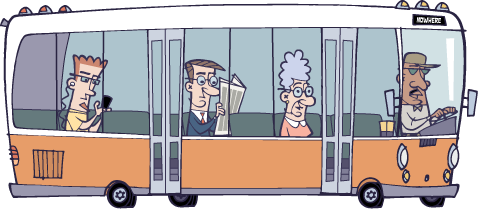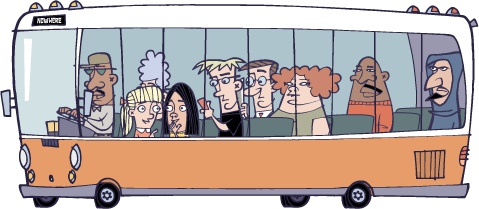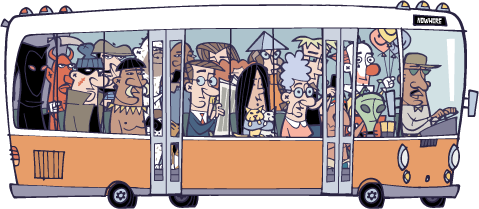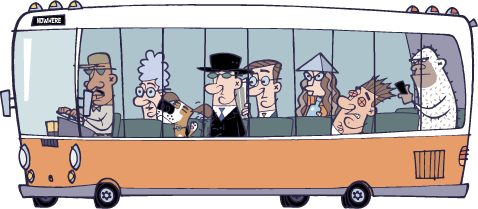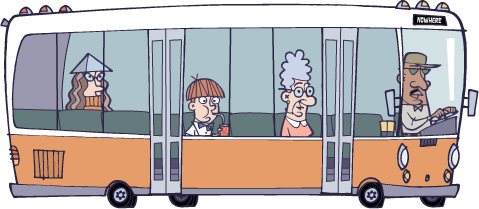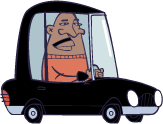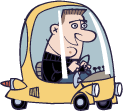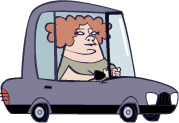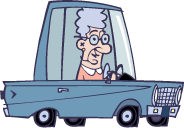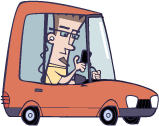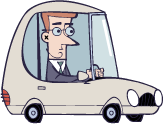





Taking the bus is the newest hot trend folks around the country are flocking to in droves. Okay, that’s obviously a lie, but I need a catchy lead-in to this bit. Anyway, sheep come in flocks and cattle go in droves, and who wants to commute like livestock? For the sake of argument, or rather to avoid any argument, let’s pretend the opening line were true.
Folks who’ve never ridden a bus will benefit from some tips on how it’s done safely and effectively. Therefore we present this bus riding primer for dummies. Which is not to say you have to be a dummy to ride the bus, but you may be one if you follow our advice.
Just so you know, our handy tips work just as well for any other type of mass transit, like subways, els, trollies, and anything else that runs on rails rather than pavement. Or a single rail in the case of a monorail. Of course “as well” can also mean “as poorly.” With all caveats and weasel words nicely in place, we can procede to the first item on our menu.
Whether you live on the bus route or not, the bus won’t stop at your front door, honk, and wait for you to finish whatever it is you’re doing and climb aboard. You’ll need to go to a bus stop. You might drive to the bus stop, but you can’t park there. Besides, it rather defeats the whole purpose.
Bus stops are usually marked with a sign or painted curb. They often have a covered shelter which protects you from foul weather. Though it won’t protect you from hygiene-challenged bums sleeping in it.
Waiting for a bus may take some time, which is why it’s called waiting. Once you find your waiting spot, either standing or sitting, you should stay there so you don’t get lost or arouse suspicion in fellow travelers from your milling about. Proper form dictates you look towards where the bus is supposed to be coming from and periodically check your watch. This doesn’t do anything but at least it helps you ignore the people there waiting with you.
Most of the time the bus will stop automatically at the bus stop. There is no need to step off the curb in front of the oncoming bus waving your arms. There may be a need for an ambulance should you try this tactic.
Busses are commonly marked with destinations, street names, route letters and numbers which are rarely where you want to go, even if you knew what any of it meant. We recommend getting on whatever bus comes along first. You may not get where you want to go, but at least you get there sooner.
Have your bus pass or exact change ready as you board. Don’t ask the driver if they can change a fifty, and don’t try to barter the fare with live poultry. In fact, don’t try to get on a bus with live poultry, especially if other passengers already have.
If you can’t decide where to sit right away, don’t worry, the friendly driver will help you. They do this by accelerating the bus away from the stop which sends you reeling into some seat or other. This seat may already be occupied, in which case bus etiquette dictates… come to think of it, there is no etiquette on a bus.
If you thought waiting for the bus was interminable, wait until you get under way. No bus ever takes the most direct route anywhere and the average speed is five miles an hour. Actually, the fastest a bus ever goes is pulling away from a bus stop when you’re running to catch it.
Busses are self-segregating, the riff-raff and thugs tend to gravitate to the rear away from the authority figure of the bus driver. Try to get a seat near the front, unless you are riff-raff or a thug and prefer the company of your own kind. On the other hand, oddballs have no seating plan other than to inevitably sit near you no matter how full or empty the bus. If you don’t know what I mean by oddball, see this.
Once you stake out your territory, either seated or standing, it must be defended. This is done by pretending not to see or hear anything or anyone else on the bus. Sunglasses, a hand-held electronic device, or a blank stare out the window all help create an insulating virtual barrier, a sort-of imaginary force field. Pretending to read a newspaper also works by erecting an actual barrier, though one made of flimsy newspaper. When you are through reading you can leave the paper in the handy recycling area called the floor.
Whatever you do, avoid eye contact like the plague. Especially if you are at the back of the bus (see above) where eye contact will be interpreted as a challenge and you’ll hear, “What are you looking at?” Caution: this is a trick question. There is no correct answer no matter how clever you think you are. Though one wonders why they have all the tattoos and piercings if nobody is supposed to look at them.
Personal space grows and shrinks in proportion to the number of people on the bus. The rule of thumb, more is less and less is more. At the point of overcrowding you reach critical mass which generates a mob. In this event all civility goes out the window, depending on how angry the mob is fellow riders sometimes go out the window, too.
As much as you might enjoy the bus riding experience as described, you’ll eventually need to get off. Look for recognizable landmarks so you don’t overshoot your stop and have to walk or, heaven forbid, take another bus back. Should you find yourself in unfamiliar surroundings, you’ve likely missed your stop. Should you find yourself the only passenger in a large parking lot full of empty busses you’ve definitely missed your stop.
On a crowded bus you’ll have to plan your exit in advance to make your way to the door before it’s too late and you’re stuck on the bus, which is sticky from who-knows-what anyway, but we’ll not get into that. This requires sidling skills to squeeze past other riders and often involves a certain amount of involuntary frottage which may be welcome or unwelcome depending on how perverted you or they are.
To get the bus to unload you at the desired stop you’ll need to ring the chime before you get there. As you approach, pull the little cord above the windows one time to alert the driver. Pull the little cord a dozen times to annoy the driver.
De-busing is best done when the bus has stopped and the exit doors are open, despite the efforts of helpful passengers who think they can squeeze you out the gap between the exit doors ahead of time. As you debark you may want to check to be sure you have any packages or items you got on with, like your laptop, wallet or young children.
After reading this you might decide the bus is not for you. There are other options. You can walk to work, for which you need to live close by. Not a great option if you work at a steel mill or the stockyards. You can ride a bike, which isn’t so great in the snow or rain but is fine in the summer if you don’t mind arriving at work tired and sweaty. Or you can work at home, which works for farmers but not so much for construction workers.
If none of those are viable options, get in your car and drive to work. Not that rush hour gridlock and parking once you get there is a joy, but at least you get to choose the radio station. Plus, in your car you can eat breakfast and catch up on your texting in privacy. In the end, the bus is a fine way to commute… for other people.
© Terry Colon, 2014
